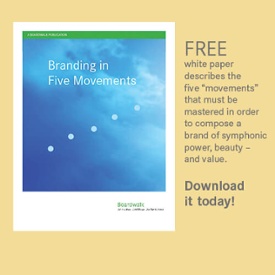From time to time, someone will ask me whether they really need to worry about branding their company. It’s usually asked by the leader of a B2B enterprise that markets to a select few customers and where the sales relationships are one-to-one, very personal. If I’m basically selling to my golfing buddies, goes the reasoning, why do I need to spend money on a logo or a website or whatever? Well, that may be true but improving sales is not the only advantage to having a brand. In fact, there are eight economic advantages to developing a strong brand. See link at the end of this article.
A variation on the question is: Do I really need a personal brand? The reasoning here is: The people I work with know who I am so why should I have to formalize it in any way? But personal branding, as a deliberate activity, sprang from the need to be noticed in the first place. It is difficult to gain recognition in a working world where people have been commoditized. Bankers, lawyers, accountants, carpenters, nurses – anybody – seem interchangeable on the surface. It’s not till you get to know people that you appreciate their strengths and weaknesses. I wrote about a perfect example of personal branding in A Brand Of One. Again, there’s a link at the end of this article.
But how to answer the original question? The best way to determine if you really need a brand is to first review what, exactly, is even able to be branded.
Topics: Super Employees, Increased Sales, Reduced Costs, Growth, Smarter Decisions, Devoted Customers, Added Value, Price Resiliency
Topics: Increased Sales, Growth, Positioning, Innovation, Strategy, Added Value
After last Tuesday’s election, 28 states plus Washington DC have legalized marijuana for medicinal use. Of those 28, seven states, plus DC, have also legalized recreational use. And of those seven, one is California with it’s huge population and habit of setting trends for the nation. Marijuana is now big business and it looks like the dominoes are falling. Soon most, if not all, of the states will have gone green. States will enjoy a significant new tax base. Marijuana abuse, if such a thing actually exists, will be seen as a health issue and not a criminal issue. That will decrease prison populations, easing overcrowding and freeing up even more budgets. All this will put enormous pressure on the federal government to legalize the “demon weed” as well. Federal legalization would mean the banks can service the industry for the first time, letting it shed its cash-only stigma. And once that happens, giant, multi-national companies like British American Tobacco and Philip Morris will want to buy a seat at the table. Finally, when the big guns get involved, you know what happens next. Branding! But what will that branding look like in the complex world of cannabis?
Topics: Growth, Positioning, Identity, Innovation, Devoted Customers, Strategy, Added Value
Most businesses, whether startups or mature, have no real inkling what their brand promise is or what it should be. As I’ve written here before, most businesses are marketing in the dark. They try different tactics, they mail out a new brochure, they launch a new website, they switch from Instagram to Snapchat, they build a bigger booth at the trade show. When one thing doesn’t work, they try another. But they’re uncertain as to where there may be obstacles, barriers or pitfalls. So there’s never much in the way of sustained effort. There’s seldom any real strategy to guide what tactics to use, in what order and with what degree of intensity. When people have to drive up sales, rapidly, they usually get straight to marketing and selling stuff. They almost never stop to reflect on what is problem that they’re really solving. More to the point, they never stop to think about who is doing the marketing and how can we get customers to fall in love with that who. Here’s how to start that process.
“How long should a brand strategy last?” It’s a question that comes up often in my branding workshops. My answer is always the same. A good brand strategy should last a company somewhere between 15 and 20 years … except if the brand in question is a fashion brand. Fashion, by its very definition, is changing all the time. So one should not expect that the same degree of longevity can be built into a fashion brand. And that brings up the sad case of Pac Sun and other “board sport” brands.
Topics: Growth, Positioning, Smarter Decisions, Strategy
Sign up – Brandtalk

Best Branding Reads
Week of December 16, 2019
20 Big Ideas that will change your world in 2020
We’re going to have to reckon with some tough choices.
How Flaws Make A Brand More Appealing
There’s an art to turning your shortcomings into strengths.
On Trend: Fashion that Resonates with Young People
People want to wear brands that make them feel good about themselves.
Integrating Brand And Talent Strategy
Once again: The same brand strategy that attracts your best customer also attracts your best employee.
Fridge-Themed Logo Mascot
Yes. A sports team has a refrigerator as a mascot.
Trademark "Sound Mark" Examples
Thank you Mark N. for sharing this after last week’s Brandtalk. Have fun with this everyone. But, fair warning, it can get addictive.
H&M’s Greenwashing: Short-Sighted and Unethical
Be sure to watch the Michael Porter video.
Recent Posts
Posts by Topic
- Added Value (26)
- Brand Lens (1)
- Branding (2)
- communication (65)
- Devoted Customers (9)
- Growth (6)
- Identity (77)
- Increased Sales (8)
- Innovation (53)
- Positioning (86)
- Price Resiliency (3)
- Reduced Costs (2)
- Smarter Decisions (19)
- Strategy (104)
- Strategy, Price Resiliency, (1)
- Super Employees (5)






